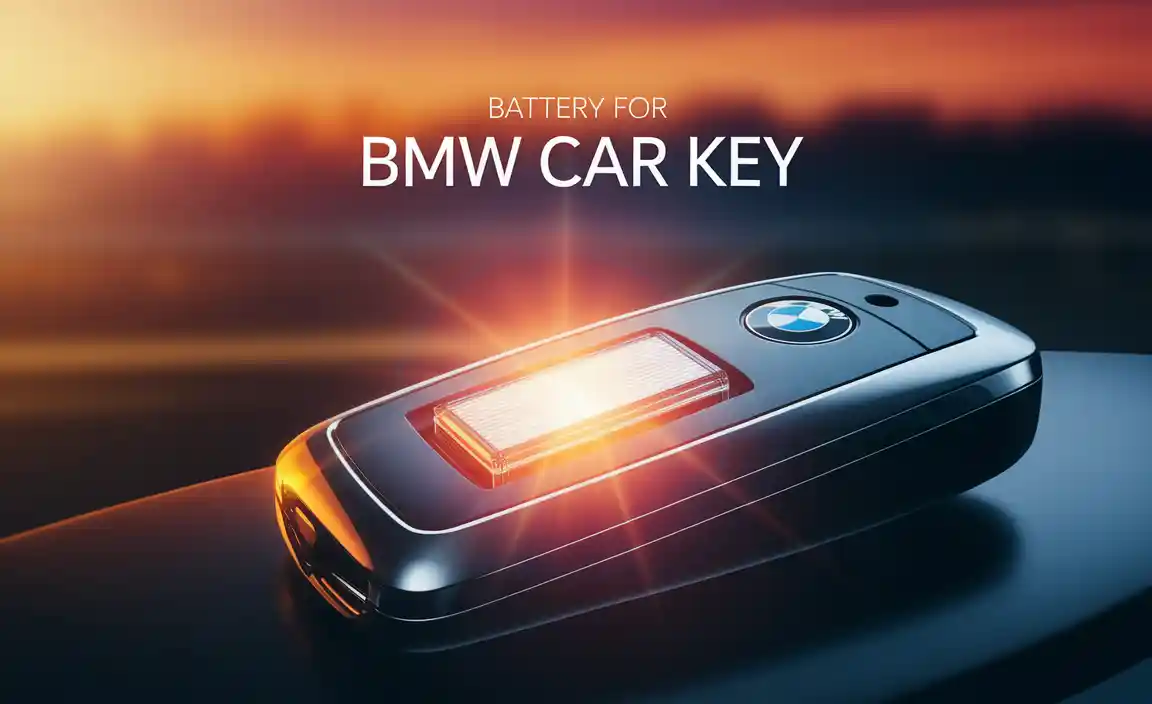Bolded Quick Summary (Top of Article)
For most 125cc ATVs, a 12-volt battery with around 9 amp-hours (Ah) and 100-130 cold-cranking amps (CCA) is the standard. Always verify your ATV’s specific manual or existing battery for exact specifications to ensure a perfect fit and optimal performance.
What Size Battery for a 125cc ATV: Your Essential Guide
Is your 125cc ATV battery giving you grief? Maybe it’s struggling to start, or perhaps it’s just plain dead. Figuring out the right battery size can feel like a puzzle, especially if you’re new to ATVs. But don’t worry, I’m here to make it simple, just like checking your car’s battery. Let’s get your ATV roaring back to life without any complicated jargon.
We’ll walk through exactly what you need to know, from understanding those little numbers on the battery case to finding the best replacement. You’ll soon be a pro at choosing the right power for your ride!
Why Battery Size Matters for Your 125cc ATV
Think of the battery as the heart of your ATV. It provides the electrical boost needed to start the engine and powers all the lights and accessories when the engine isn’t running. Getting the correct size battery is super important. Too small, and it might not have enough power to start your engine reliably, especially on a cold morning. Too big, and it might not fit in the battery tray, or you might be paying for more power than your ATV can actually use.
A battery that’s just right delivers consistent power, starts your ATV easily, and helps everything run smoothly. We want to make sure your ATV has the energy it needs to tackle those trails!
Understanding ATV Battery Terminology: The Basics
Before we dive into sizes, let’s quickly look at a few terms you’ll see on a battery. Don’t let them intimidate you; they’re pretty straightforward:
- Voltage (V): This tells you the electrical potential of the battery. Most 125cc ATVs use a 12-volt system. It’s like the “strength” of the electrical push.
- Amp-Hours (Ah): This number indicates how much energy the battery can store and deliver over time. A higher Ah generally means the battery can power your ATV for longer periods or handle more electrical demands. For a 125cc ATV, you’ll typically see numbers around 9 Ah.
- Cold Cranking Amps (CCA): This is a crucial measurement, especially if you ride in cooler weather. CCA tells you how much power the battery can deliver for starting an engine in freezing temperatures (0°F or -18°C). The higher the CCA, the easier it will be to start your ATV when it’s cold. For 125cc ATVs, 100-130 CCA is a common range.
- Terminal Type and Layout: Batteries have positive (+) and negative (-) terminals. You’ll need to make sure the new battery’s terminals match the layout and polarity of your old one, or the cables might not reach.
What Size Battery is Typically Used for a 125cc ATV?
For the vast majority of 125cc ATVs, including popular models for youth riders or general recreational use, the standard battery specifications are quite consistent. You’re generally looking for:
- Voltage: 12V
- Amp-Hours (Ah): Commonly between 8 Ah and 10 Ah. A 9 Ah battery is a very frequent choice.
- Cold Cranking Amps (CCA): Typically in the range of 100 to 130 CCA.
These specifications are designed to provide enough power to reliably start the small engine and support the basic electrical needs of a 125cc machine. Think of it as a good starting point. However, there can be slight variations between different ATV manufacturers and models.
How to Find the EXACT Battery Size for YOUR 125cc ATV
While the general specs are helpful, finding the exact right battery for your specific ATV is key. Here’s how to do it:
1. Check Your ATV’s Owner’s Manual
This is your golden ticket! Your ATV’s manual will have a section on specifications or maintenance. It will clearly state the recommended battery type, voltage, Ah, and CCA. If you don’t have a physical copy, try searching online for “[Your ATV Make and Model] owner’s manual PDF”. For example, searching for “Honda TRX90 owner’s manual PDF” would be a great start.
2. Inspect the Old Battery
This is often the easiest method. Take a look at the battery currently in your ATV. Most batteries have labels printed on the side or top that indicate their specifications. Look for numbers like “12V,” “9Ah,” “100CCA,” or specific battery model numbers.
Safety First! When examining the old battery, wear gloves and eye protection. Batteries can contain corrosive acid. If the battery is damaged or leaking, handle it with extreme care and consider it unsafe to read directly. If that’s the case, rely on option 1 or 3.
3. Use Online Battery Finder Tools
Many battery manufacturers and reputable online retailers have “battery finder” tools on their websites. You simply input your ATV’s year, make, and model, and the tool will suggest compatible batteries. This is a great backup if your manual is lost or the old battery label is unreadable.
For example, sites like BatteryStuff’s ATV Battery Finder allow you to search by vehicle type. These tools are very reliable but always double-check the results against your findings from other methods if possible.
4. Identify the Battery Group Size (If Applicable)
While less common for smaller ATVs compared to cars, some batteries might have a “group size” designation (like “YTX7L-BS” or “GTX5L-BS”). This code bundles voltage, dimensions, and terminal location into one identifier. If your old battery has one, it’s a strong indicator of what you need. The “BS” at the end often means “Battery Specification” and implies it’s sealed and maintenance-free.
Common Battery Types for 125cc ATVs
When you go to buy a replacement, you’ll likely encounter a few different battery technologies. For 125cc ATVs, most are sealed and designed for minimal fuss:
Sealed Lead-Acid (SLA) Batteries
These are the most common type for ATVs. They require no regular addition of water. They are further categorized:
- Absorbent Glass Mat (AGM): This is the most popular choice for ATVs. The electrolyte (acid) is absorbed into fiberglass mats. They are vibration-resistant, spill-proof, and offer excellent performance. They are often what comes as original equipment.
- Gel Cell: The electrolyte is mixed with silica to form a gel. These are also spill-proof and can be mounted in almost any position. They tend to be a bit more expensive and can sometimes have slightly lower cranking power than AGM batteries.
Lithium-Ion (LiFePO4) Batteries
These are lighter and can offer more power for their size. However, they are significantly more expensive and require a specific type of charger. While gaining popularity, they are less common as a direct replacement for a standard 125cc ATV battery unless you’re looking for a performance upgrade and are prepared for the cost and charging requirements.
For most 125cc ATV owners, an AGM battery is the best balance of performance, cost, and ease of use. They are essentially a direct, often improved, replacement for the original battery.
Key Specifications to Match: A Comparison Table
Here’s a quick way to see the typical specs and what they mean. Remember, always confirm with your ATV’s manual!
| Specification | Typical Range for 125cc ATV | What it Means for You |
|---|---|---|
| Voltage (V) | 12V | The standard electrical potential. Almost all 125cc ATVs use 12V. |
| Amp-Hours (Ah) | 8 Ah – 10 Ah (9 Ah is common) | How long the battery can supply power. Higher means more reserve capacity. Stick close to the original specification. |
| Cold Cranking Amps (CCA) | 100 – 130 CCA | Power for starting in cold weather. More CCA is better for reliable starts in low temperatures. |
| Physical Dimensions (L x W x H) | Varies by model | The battery MUST fit physically into your ATV’s battery tray and allow the seat or cover to close properly. Measure the old one or check your manual! |
| Terminal Type & Orientation | Varies by model | Ensure the positive and negative terminals are in the same locations as your old battery so your cables reach. |
Example of a Battery Code: You might see a battery code like YTX7L-BS. This code often implies:
- Y: Manufacturer prefix (can vary)
- T: Type (T for Thin)
- X: Special construction
- 7: Relative power/capacity rating (higher number generally means more capacity)
- L: Terminal post configuration (L for Left positive, R for Right positive)
- BS: Sealed, maintenance-free battery
If your old battery has a code like this, search for that exact code or one with a similar performance rating.
When to Replace Your 125cc ATV Battery
Batteries don’t last forever. If you notice any of these signs, it’s probably time for a new one:
- Slow Cranking: The engine turns over slower than usual when you try to start it.
- Dim Lights: Headlights or other lights seem dimmer than they should.
- Frequent Need for Charging: You find yourself having to charge the battery more often.
- Corrosion on Terminals: While some corrosion can be cleaned, excessive or rapidly reappearing corrosion can indicate a failing battery.
- Physical Swelling or Leaking: If the battery case looks swollen, cracked, or is leaking fluid, it’s dangerous and needs immediate replacement.
- Age: Most ATV batteries last between 3 to 5 years. If yours is older than that, even if it seems to be working, it’s on borrowed time.
How to Choose the Right Replacement Battery: Step-by-Step
Ready to pick out that new battery? Here’s a simple process:
- Find Your ATV’s Exact Battery Requirements: Use the methods described earlier (owner’s manual, old battery label, online finder) to get the precise specs: Voltage, Ah, CCA, and physical dimensions.
- Prioritize Key Specs:
- Voltage: Must match (almost always 12V for 125cc).
- Dimensions: The new battery MUST fit. Measure your battery tray and compare to the dimensions listed for the new battery.
- Terminal Configuration: Ensure the positive and negative posts are on the correct sides for your cables to reach.
- Ah Rating: Stay close to the original. You can go slightly higher (e.g., from 8Ah to 9Ah) if the dimensions and terminal layout match, but don’t go drastically lower.
- CCA Rating: It’s generally safe to get a battery with a CCA rating equal to or higher than the original. This provides better starting power.
- Choose a Reputable Brand: Stick with well-known battery manufacturers. Brands like Yuasa, Shorai, WPS (Western Power Sports), and MotoBatt are trusted in the powersports industry.
- Decide on Battery Type: For most 125cc ATVs, an AGM (Absorbent Glass Mat) battery is an excellent, hassle-free choice. They offer great performance and are maintenance-free.
- Check the Date Code: Batteries have a shelf life. Look for a recent manufacturing date. Batteries can lose charge over time in storage. Some vendors might stamp a month/year code on the battery.
- Purchase and Installation: Once you’ve chosen your battery, it’s time to buy it. Installation is usually straightforward, but we’ll cover that next.
Installing Your New 125cc ATV Battery: A Simple Process
Replacing your ATV battery is a DIY job that most people can handle. Safety is always the priority!
Tools You’ll Likely Need:
- New 12V ATV battery (correct size!)
- Wrench or socket set (usually 8mm, 10mm, or 13mm)
- Battery terminal cleaner or wire brush
- Gloves and eye protection
- Dielectric grease or anti-corrosion spray (optional but recommended)
- Small screwdriver (for tie-downs or covers)
Step-by-Step Installation:
- Preparation: Park your ATV on a flat surface and turn off the engine. Make sure the ignition is off. Put on your gloves and eye protection.
- Locate the Battery: The battery is usually under the seat, in the front rack area, or near the engine. Consult your manual if you can’t find it. You might need to remove a seat, a plastic cover, or a rack to access it.
- Disconnect the Old Battery – NEGATIVE FIRST! The single most important safety rule when disconnecting a battery is to always remove the NEGATIVE (-) terminal cable first. This prevents accidental accidental short circuits. Loosen the nut on the negative terminal clamp and carefully twist and pull the cable off the terminal.
- Disconnect the POSITIVE Terminal: Now, disconnect the POSITIVE (+) terminal cable in the same way. Once both cables are off, set them aside so they can’t accidentally touch the battery terminals.
- Remove the Old Battery: There might be a battery tie-down strap, bracket, or clip holding the battery in place. Remove this. Carefully lift the old battery straight up and out of the tray. Be mindful that it can be heavy, and if it’s old, there might be some leakage, so handle with care.
- Clean the Battery Tray and Cables: Inspect the battery tray for dirt, debris, or corrosion. Clean it out. Use a battery terminal cleaner or wire brush to clean the inside of the cable clamps. Shiny metal is what you want for a good connection.
- Install the New Battery: Place the new battery into the tray, ensuring it’s oriented correctly with the positive and negative terminals in the right positions. Make sure it sits securely.
- Secure the New Battery: Reinstall any tie-downs, brackets, or clips to hold the new battery firmly in place. It should not be able to move around.
- Connect the New Battery – POSITIVE FIRST! Now it’s time to hook up the new power. Connect the POSITIVE (+) terminal cable first. Make sure the clamp is seated firmly on the terminal post. Tighten the nut.
- Connect the NEGATIVE Terminal: Connect the NEGATIVE (-) terminal cable second. Again, ensure a good, tight connection.
- Apply Terminal Protection (Optional): You can spray a bit of dielectric grease or anti-corrosion spray onto the terminals and clamps. This helps prevent corrosion and ensures good conductivity.
- Reassemble: Replace any covers, seats, or racks you removed.
- Test: Turn on the ignition and try to start your ATV. It should fire up much more eagerly! Test your lights and other electrical components.
If you’re unsure about any step, it’s always best to consult your ATV’s service manual or seek help from a qualified mechanic. For more information on battery safety, the U.S. Department of Energy provides resources on battery care and recycling, which often include safety guidelines: DOE Battery Recycling Information.
Frequently Asked Questions (FAQ)
Q1: Can I use a car battery on my 125cc ATV?
Generally, no. Car batteries are much larger, heavier, and



